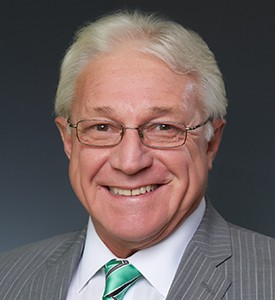
At BIO, we are very hard at work to protect innovation and we will ultimately succeed in the policy arena. We want to encourage companies to be part of the solution and to be thoughtful about their pricing. Everyone in this industry has to be politically involved, from the bench scientists to the CEOs – we are facing a strong headwind and must act together to drive the industry forward.”
James Greenwood
PRESIDENT & CEO, BIOTECHNOLOGY INNOVATION ORGANIZATION
What are BIO’s mandate and core areas of focus in driving innovation?
BIO is reaching its 26th year of operation, and today we represent about 1,000 members, 85% of which are in the biopharmaceutical space and the remaining 15% in areas such as the agricultural side of biotechnology, biomaterials and biofuels and bioterrorism. Our activities are twofold. Firstly, there is the advocacy side, which involves developing the policies we believe are conducive to the success of innovative companies and working hard against policies we believe will be detrimental. Secondly, we hold conferences and events through which companies can connect with investors.
At the moment, drug pricing is at the epicenter of our focus. The criticism directed at drug companies over pricing has been ongoing for several years, but is currently at its most intense due to a number of factors. We see this criticism coming from the media, policy makers, some patient groups and healthcare providers.
To what extent is the criticism around drug pricing justified, and what is at the root of the challenges around patient access and affordability?
Many drugs today are quite expensive. This is because 90% of clinical programs to develop new drugs fail – the basic economics of our industry are high risk, high reward. In the period that the drug is under patent, the price point must be high enough to attract the initial interest from investors and cover reimbursement. Pressure is also mounting because about half of all out-of-pocket spending today occurs when patients are in their deductible. It is the design of the insurance plan that drives the patient’s financial experience. In addition, when Obamacare began, the health insurers low-balled their premiums to capture market share. They then realized they set these premiums too low and had to raise them, and blamed drug pricing as the root cause.
We often hear the phrase “sky-rocketing drug prices” in the media and from policy makers, but all the data shows this is not the case. In fact, net drug price increases have been on the decline and in single digits for the last five or six years. This includes innovative as well as generic drugs, despite the outliers we see from time to time.
How great a threat is the current rhetoric around drug pricing to medical innovation and what positive steps are being made to ensure innovation persists?
Medical innovation is simultaneously at both its moment of greatest hope and under the greatest political pressure we have seen. By nature, science is always advancing, so our capacity to provide treatments and cures has never been better. However, the potential policies following President Trump’s emphasis on high drug prices over the course of his 2016 campaign and ever since could be very detrimental to that progress and innovation. We have 100 new members of Congress that were elected in a climate where drug pricing was a major factor. The threat is very real, and we are busy figuring out how to explain our business model – it is often not understood that the private sector contributes the lion’s share of R&D money while taking on all of the risk. Some policy makers now even believe that IP and patenting is a bad thing, without understanding that without this protection companies will not be able to find investment for their innovation. 100 members of Congress have signed onto a bill that would enable the Secretary of Health and Human Services to compulsorily license a company’s IP to generic companies if that company does not accept the pricing negotiated in the Medicare Part D program.
We believe that a big part of the solution is to focus on patients’ out-of-pocket cost, because this is what drives the pricing conversation. Even in the Federal Medicare Part D drug program, one million patients pay more than US$2,000 per year out of pocket, and some pay up to five times as much. There is a moral question here – it is ethically wrong for anyone to go without medicine because the cost makes it unaffordable.
What is BIO doing to educate both the public and policy makers?
Three years ago, we started a “Time is Precious” campaign, based on the premise that our industry enables quality time with loved ones beyond what would otherwise be possible. Nevertheless, the industry cannot communicate itself out of the current negative perception. We have tried highlighting that we consistently only account for 14% of the healthcare spend; we have tried communicating that our prices are not sky-rocketing; we have tried saying that our drug development programs fail 90% of the time and that price controls would curb investment; we have produced TV ads and radio ads and presented all around the world. However, when a patient enters a pharmacy and cannot afford to pay for their medicine, none of that matters. This is why focusing on the out-of-pocket cost is essential.
As some companies look towards a “direct-to-patient” supply chain, do you expect to see major changes with respect to the “middle-men”?
The original notion of Pharmacy Benefit Managers (PBMs) was to negotiate with the drug manufacturers to secure benefits for employees on behalf of the employers. This made sense, since group purchasing organizations offer leverage. What they have evolved into, however, is something quite different. When companies have roughly equivalent drugs to sell, the PBM no longer looks for the best price to benefit the people it represents. Instead, it asks for the biggest rebate, sometimes even requesting that the company raise the price of their drug to offer a bigger rebate. The PBMs therefore tend to cover the drug that includes the biggest rebate rather than the one that is least expensive for the people they are working on behalf of. This has become increasingly recognized, and the PBMs are very much under the gun. Out of all the Fortune 50 companies, only one is a biopharmaceutical company, whereas there are a number of PBMs and insurers listed, as well as drug distributors.
Kick-backs are frequently against the law, but there has been a safe harbor whereby a rebate is not considered a kick-back. The Secretary of Health and Human Services has just announced the abolishment of that safe harbor, taking the rebate system out of Medicare Part D entirely. This is a very positive step. There will likely be a very rapid evolution of the marketplace to make the system more efficient.
While we see certain areas in the United States with a very high concentration of activity, innovation is by no means limited to a handful of hubs. What work is BIO doing to raise the visibility of companies across the country to the investment community and ensure innovation gets the best chance of reaching the market regardless of geography?
Notably, the most widely-recognized hubs of activity have grown around great universities. These universities tend to attract significant NIH funding and will license great technology to industry under the Bayh-Dole Act. At the BIO International Convention each year, almost all states have a pavilion – they all want to have biotech hubs because the industry is seen as the future for economic strength and an area in which the United States dominates. We have an almost infinite amount to learn about biology, and an infinite number of applications within healthcare.
States can encourage and support technology transfer from universities and company formation and retention through initiatives and incentives. The hardest part is attracting venture capital, since venture capital firms tend to want to place an executive on the company board and that executive is likely to want to keep their portfolio companies close to each other geographically. However, we are seeing some firms consider their opportunities more stealthily and starting to identify prospects in lesser-known areas. We also see differing areas of specialization between states, causing some to garner greater attention.
What are your expectations for the role China will play in advancing biotech innovation?
For some time, biotech has been one of China’s seven pillars of focus within its plan for economic growth. In the past, there have been a number of inhibiting factors. For example, the CFDA was terribly understaffed – a challenge we have helped to address. Historically, IP protection has also been a great challenge, but this is also improving.
China is a huge market, and there is also a tremendous amount of money coming from Chinese investors into the U.S. biotech industry. While we understand the administration’s concern around IP protection due to previous occurrences, we are very troubled by the potential impact that increasing scrutiny would have on the ability of U.S. biotechs to access this important source of funding. We are working with the administration to find our way through this.
Taking into account the current challenges faced by U.S. biopharmaceutical companies, how robust is the industry likely to remain through 2019 and 2020?
The reason U.S.-based companies produce such a high percentage of the world’s new molecules is that the United States is close to a free market. While the industry has to yield about US$90 billion according to Federal requirements, such as the state rebates in the Medicaid program and 70% discounts in the donut hole in Medicare Part D, before paying corporate taxes, operating closely to a free market drives innovation not only in the United States but also in Europe and Asia since companies in these jurisdictions often look to the U.S. market to recover their investments.
Our major focus at the moment is policy. We are likely to face some tough legislation and proposals from the administration as policy makers respond to the outcry against drug pricing due to the perception that the drug developers are to blame. We have our own policy ideas focused on protecting patients’ out-of-pocket costs, and we will focus on getting policy makers to understand the real problem. High out-of-pocket costs not only negatively impact patients; they also have the potential to destroy adherence, often resulting in hospitalization and costing more money in care.
What would your message to the industry be as we move through 2019 and towards 2020’s presidential election?
Be not disenchanted in challenging times. At BIO, we are very hard at work to protect innovation and we will ultimately succeed in the policy arena. We want to encourage companies to be part of the solution and to be thoughtful about their pricing. Everyone in this industry has to be politically involved, from the bench scientists to the CEOs – we are facing a strong headwind and must act together to drive the industry forward.










